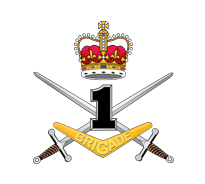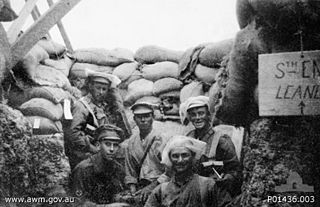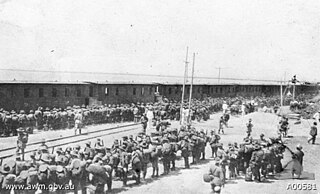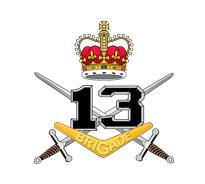
7th Brigade is a combined arms formation or brigade of the Australian Army. The brigade was first raised in 1912 as a Militia formation, although it was re-formed as part of the First Australian Imperial Force in early 1915 for service during World War I. It subsequently saw action at Gallipoli and on the Western Front during the war. Following the end of the war the brigade was disbanded in 1919 before being re-raised in 1921 as part of the Citizens Force. During World War II the brigade took part in the fighting against the Japanese in New Guinea and on Bougainville. Today, the 7th Brigade is part of Forces Command and is based in Brisbane, Queensland and is composed mainly of units of the Regular Army. While the brigade has not deployed as a whole unit since World War II, component units have deployed on operations to East Timor, the Solomon Islands, Iraq and Afghanistan.

1st Brigade is a combined arms formation of the Australian Army. Formed in 1903 as a militia formation based in New South Wales, it was reconstituted as part of the Australian Imperial Force in 1914 for service during World War I, the brigade fought at Gallipoli and on the Western Front before being disbanded in mid-1919. In 1921, the 1st Brigade was re-raised as a unit of Australia's part-time military forces, based in New South Wales. During World War II the brigade undertook defensive duties before being disbanded. In 1948, it was re-raised as an integral part of the Australian Regular Army. Currently the brigade is based at Robertson Barracks in Darwin and at RAAF Base Edinburgh near Adelaide, South Australia. It is the first of the Australian Army brigades to be re-organised as a combat brigade under Plan Beersheba.

The Royal New South Wales Regiment (RNSWR) is a reserve infantry regiment of the Australian Army based in the state of New South Wales.

The 1st Battalion was an infantry battalion of the Australian Army. Although its numerical name was designated during the First World War, the 1st Battalion can trace its lineage back to 1854, when a unit of the Volunteer Rifles was raised in Sydney, New South Wales. This unit has since been redesignated a number of times, but through its links with the units of the colonial NSW defence force, the battalion's history includes services in Sudan and South Africa. During the First World War, the 1st Battalion was raised for overseas service in 1914 as part of the First Australian Imperial Force. Attached to the 1st Brigade, the battalion served in Egypt initially before taking part in the fighting in Gallipoli against the Turks. Later the battalion was sent to the Western Front where it fought in the trenches in France and Belgium as part of the Australian Corps. Following the end of the war the battalion was disbanded in 1919.

The 3rd Battalion was an infantry battalion of the Australian Army. Originally raised as part of the First Australian Imperial Force for service during World War I, the battalion formed part of the 1st Brigade, attached to the 1st Division. It was formed shortly after the war broke out and was among the first Australian units to be sent overseas, arriving in Egypt in December 1914. In April 1915 the battalion participated in the Landing at Anzac Cove, coming ashore in the second and third waves. In December 1915 the 3rd Battalion was evacuated from the Gallipoli peninsula and withdrawn to Egypt again, where it took part in the defence of the Suez Canal before being sent to France to fight on the Western Front in March 1916. For the next two and a half years the unit would serve in the trenches in France and Belgium and would take part in many of the major battles fought during that time. In May 1919, following the end of the war, the battalion was disbanded and its personnel repatriated back to Australia.

The 4th Battalion was an infantry battalion of the Australian Army. Originally raised as part of the First Australian Imperial Force during the First World War, the battalion formed part of the 1st Brigade, attached to the 1st Division. During the war the battalion fought at Gallipoli and in the trenches on the Western Front, before being disbanded in 1919. In 1921, the battalion was re-raised as a militia unit and designated as the "4th Battalion ", adopting the designation of the Australian Rifles militia unit from which many of the battalion's recruits had come during the war. In 1930, the battalion was amalgamated with the 3rd Battalion and they remained linked until 1936, when they were delinked.
The 5th Battalion was an infantry battalion of the Australian Army. Raised in Victoria as part of the First Australian Imperial Force for service during World War I, the battalion formed part of the 2nd Brigade, attached to the 1st Division. It participated in the landing at Anzac Cove on 25 April 1915, coming ashore in the second wave, before taking part in the fighting at Krithia and then at Lone Pine. In December 1915, the battalion was withdrawn from the peninsula and returned to Egypt where it was involved in defending the Suez Canal until being transferred to the Western Front in France in early 1916. After that, over the course of the next two and a half years the 5th Battalion was rotated in and out of the front line and took part in a number of significant battles including at Pozieres, Ypres, Amiens and the Hindenburg Line. Following the end of the war, the battalion was disbanded and its personnel returned to Australia. The battalion was re-raised during the inter-war years as a part-time unit and was later mobilised during World War II, but did not serve overseas. During the post war period, the battalion has existed at various times before being subsumed into the 5th/6th Battalion, Royal Victoria Regiment.

The 12th Battalion was an infantry battalion originally raised for the First Australian Imperial Force during the First World War. The battalion was recruited from Tasmania, South Australia and Western Australia and formed part of the 3rd Brigade, 1st Division. It served throughout the war, firstly during the Gallipoli Campaign and then on the Western Front. During the interwar years, the 12th Battalion was re-raised as a part-time military unit and during the Second World War undertook garrison duties in Australia, but did not see combat. Today its lineage is perpetuated by the 12th/40th Battalion, Royal Tasmania Regiment, a unit which continues to serve in the Australian Army Reserve.

The 9th Brigade is a Reserve formation of the Australian Army headquartered at Keswick Barracks in Keswick, South Australia, with elements located in New South Wales and South Australia. The brigade was first raised in 1912 in New South Wales following the introduction of the compulsory training scheme.
The 4th Brigade is a brigade-level formation of the Australian Army. Originally formed in 1912 as a Militia formation, the brigade was re-raised for service during World War I, elements of the brigade served at Gallipoli and in the trenches on the Western Front before being disbanded in 1919. In 1921, the brigade was re-raised as a unit of Australia's part-time military forces, based in the state of Victoria. During World War II the brigade served in the New Guinea and New Britain campaigns. Following the war, the brigade formed part of the 3rd Division, however, it was later reallocated to the 2nd Division, where it serves as a Reserve combined-arms formation including units and personnel from all corps of the Army including armoured, infantry, artillery, engineers, signals and ordnance.

The 17th Battalion was an infantry battalion of the Australian Army. Although its numerical designation was bestowed upon it during World War I, the 17th Battalion can trace its lineage back to 1860, when a unit of the New South Wales Volunteer Rifles was raised in St Leonards, New South Wales. This unit has since been disbanded and reformed a number times. Through its links with the units of the colonial New South Wales defence force, the battalion's history includes service in the Sudan and South Africa. During World War I, the 17th Battalion was raised for overseas service as part of the Australian Imperial Force. Attached to the 5th Brigade, 2nd Division, the battalion was raised in 1915 and sent to Egypt initially, before taking part in the fighting at Gallipoli against the Turks. Later the battalion was sent to the Western Front in France and Belgium, where it served in the trenches as part of the Australian Corps. Throughout the course of the war, the battalion won numerous battle honours and its members received many individual awards, however, at the end of the war the battalion was disbanded in April 1919.

The 13th Brigade is an Army Reserve formation of the Australian Army. Originally formed in 1912 as a Militia formation in Victoria, the brigade was re-raised as a First Australian Imperial Force unit during World War I and fought on the Western Front. In the interwar years, the brigade was re-raised as a part-time formation based in Western Australia and later fought in the New Britain Campaign during World War II.

The 16th Battalion, Royal Western Australia Regiment is an Australian Army reserve infantry battalion located in Western Australia and one of the two battalions of the Royal Western Australia Regiment. The battalion was first formed during the First World War, during which it fought during the Gallipoli Campaign and on the Western Front in France and Belgium as part of the Australian Imperial Force. It was re-formed as a part-time unit in Western Australia during the inter-war years, and served in the New Britain Campaign against the Japanese during the Second World War. In the post war years, the battalion became part of the Royal Western Australia Regiment and currently forms part of the 13th Brigade.

The 41st Battalion, Royal New South Wales Regiment,, is an infantry battalion of the Australian Army. An Army Reserve unit, it is one of four battalions of the Royal New South Wales Regiment and is attached to the 5th Brigade, 2nd Division. It is based in northern New South Wales, with its headquarters in Lismore and depots in a number of locations including Tweed Heads, Grafton, Kempsey, Port Macquarie and Coffs Harbour. In its present form the battalion was raised in 1965, however, it can trace its lineage back to a couple of Scottish Rifles units formed in the 1800s in Byron Bay and Maclean. It also perpetuates the battle honours and traditions of the 41st Bn AIF, that served on the Western Front during World War I.

The 11th/28th Battalion, Royal Western Australia Regiment is a Reserve infantry battalion of the Australian Army. Located in Western Australia, it is one of the two battalions of the Royal Western Australia Regiment which forms the infantry component of the 13th Brigade.

The 13th Battalion was an infantry battalion of the Australian Army. Originally raised for the 1st Australian Imperial Force during the First World War, it was formed just six weeks after the start of the war. Along with the 14th, 15th and 16th Battalions which were recruited from New South Wales, it formed the 4th Brigade. The battalion saw service initially at Gallipoli before being transferred to France in 1916. For the next two years it fought in the trenches of the Western Front, earning numerous battle honours in the process.

The 18th Battalion was an infantry battalion of the Australian Army. During World War I, the battalion was raised in 1915 as part of the Australian Imperial Force, attached to the 5th Brigade, of the 2nd Division. It was sent initially to Gallipoli, where it suffered many casualties before it was withdrawn from the line and sent to France and Belgium, where it served at the Western Front as part of the Australian Corps and took part in most of the major battles between 1916 and 1918. The battalion's last engagement of the war was at Montbrehain in October 1918 and it was disbanded in April 1919.

The 45th Battalion was an infantry battalion of the Australian Army. Raised for service during World War I, the battalion served in the trenches on the Western Front in France and Belgium from mid-1916 until the end of hostilities in November 1918. Following this, it was disbanded in May 1919. Later, in 1921, the battalion was re-raised as a part-time unit of the Citizens Force, based in New South Wales. The battalion remained on the order of battle until 1942, when it was merged with the 1st Battalion as part of a force reduction that was undertaken at that time in response to an over mobilisation of the Australian military in the early part of World War II. In 1948, the battalion was re-raised again and remained on the order of battle until 1960 when it was absorbed into the Royal New South Wales Regiment.

The 2nd Health Brigade (2HB) is an Australian Army brigade. The 2nd Brigade was formed in 1903 as a militia infantry formation based in Victoria, the brigade later served during the First World War as part of the Australian Imperial Force, allocated to the 1st Division. During the war, the 2nd Brigade took part in the fighting at Gallipoli, including the Battle of Krithia where it lost almost a third of its strength. Later they took part in the Battle of Lone Pine before being withdrawn back to Egypt in December 1915. Following this the brigade was transferred to the Western Front in France and Belgium where, between March 1916 and the armistice in November 1918, they took part in most of the major Allied operations.

The 28th Battalion was an infantry battalion of the Australian Army. It was raised in early 1915 as part of the First Australian Imperial Force for service during the First World War and formed part of the 7th Brigade, attached to the 2nd Division. It fought during the final stages of the Gallipoli campaign in late 1915 and then on the Western Front between 1916 and 1918. At the end of the war, the 28th was disbanded in 1919 but was re-raised in 1921, as a part-time unit based in Western Australia. During the Second World War, the 28th undertook defensive duties in Australia for the majority of the conflict, before seeing action against the Japanese in the New Britain campaign in 1944–1945. The battalion was disbanded in March 1946 but was re-formed in 1948 as an amalgamated unit with the 16th Battalion, before being unlinked in 1952 and re-raised as a full battalion following the reintroduction of national service. It remained on the Australian Army's order of battle until 1960 when it was subsumed into the Royal Western Australia Regiment, but was later re-raised in 1966 as a remote area infantry battalion. In 1977, the 28th was reduced to an independent rifle company, and in 1987 was amalgamated into the 11th/28th Battalion, Royal Western Australia Regiment.



















